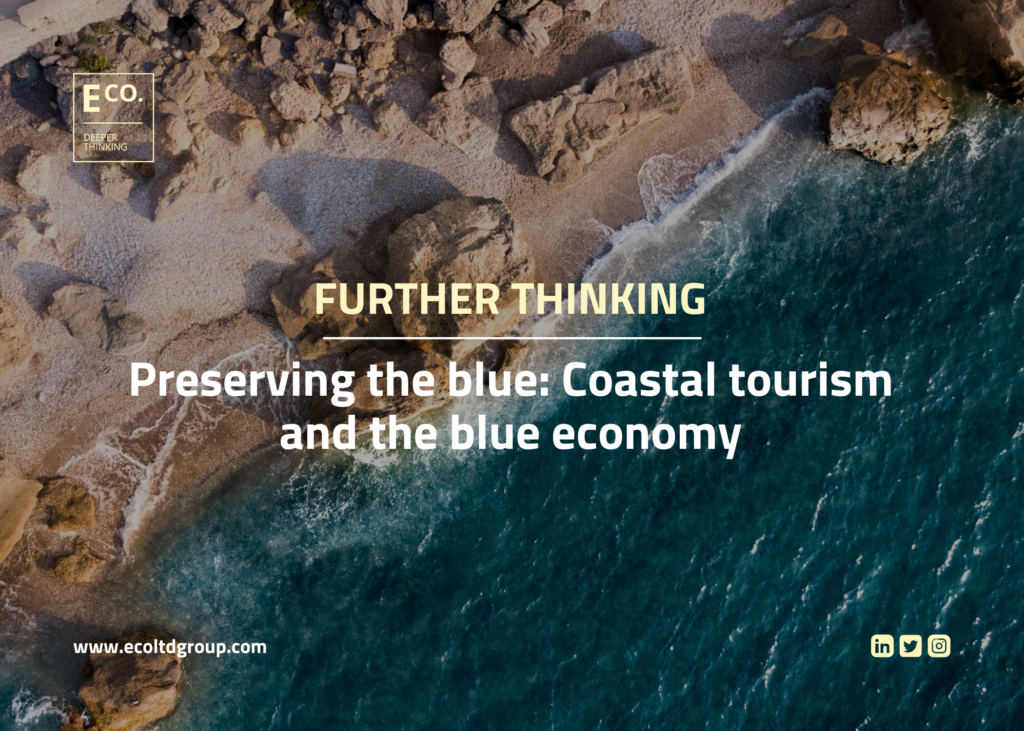Preserving the blue: Coastal tourism and the blue economy
17 April 2024, Category: All insights, News, Tags: blue economy, coastal tourism, SIDs, sustainable development, tourism

Of the large array of Sustainable Development Goals, no. 14 is known as ‘Life Below Water’. The remit of this goal concerns the conservation and safeguarding of the earth’s oceans, seas, and marine resources for sustainable development.
Our oceans are an important, yet finite, source of food, minerals, and energy, and are being increasingly used for recreation and coastal tourism. Coastal and marine tourism represents a significant component of a growing, sustainable blue economy, so much so, that it is projected that by 2030 it will increase by 26% – becoming the largest value-adding segment of the ocean economy.
Worldwide, almost half of all tourists choose a coastal destination for their vacations – so how does this impact the ocean economy? This article details the interconnectedness of coastal tourism and the blue economy, expanding on its benefits to economic growth as well as its challenges for surrounding habitats.
- The benefits of coastal tourism
- Adverse impacts of tourism
- Coastal tourism and the blue economy: Moving forward
The benefits of coastal tourism
Coastal tourism is an essential cog in the blue economy machine.
For developing countries and areas, such as the Caribbean, there is a strong dependence on tourism for economic enhancement. The UN Conference on Trade and Development revealed that the ocean economy represents 30-50% of the GDP of most Small Island Developing States (SIDS). In 2023, the Dominican Republic (the most visited Caribbean Island) welcomed 7,863,542 tourists by air and 2,168,209 by sea, reaching a record-breaking 10 million+ visitors. Similarly, Zanzibar received 678,570 visitors in 2023, resulting in an 18% increase compared to 2022. It is clear that such destinations are only getting more popular resulting in a boost to local economies. In locations that house reefs, corals, and mangroves, this can promote reef tourism, encouraging tourists to engage in snorkelling, diving, and swimming activities. From the figure below provided by the World Economic Forum, it is estimated that reef tourism contributes to a staggering $36 million of tourist revenue globally, per year.
Tourism can have a number of benefits outside of economic gain. For example, local communities can be directly employed at tourist destinations and engage in activities within the accommodation, retail, and transportation sectors. Community enhancement can also be developed further as tourism can contribute to cultural preservation, ocean conservation, and social understanding of the local setting. Other benefits include infrastructure innovation of offshore wind, port development, and aquaculture that could be beneficial for local fishing communities.
Adverse impacts of tourism
Despite coastal tourism generating so called ‘ocean-wealth’, the surge in visitor numbers can also lead to adverse impacts. The surrounding natural environment can be negatively impacted, the cost of living can increase for its residents, and tourism demands can strain resources. Therefore, whilst tourism can bring in revenue for local communities, it needs proper management to ensure those benefits reach those who need them most. By implementing the necessary mechanisms, tourism profits can be effectively channelled towards appropriate targets.
The main negative impacts of coastal tourism on the surrounding ecosystems are beach and shoreline erosion, coral reef and other aquatic habitat damage, plastic waste, water pollution, and overfishing. The blue economy is reliant on healthy marine ecosystems to ensure the continuation of coastal tourism. Yet the aforementioned adverse impacts threaten the longevity of this important economic service.
During peak tourist season, marine plastic litter in the coastal Mediterranean region increases by 40%. Similarly, in the Eastern Caribbean Islands of Grenada, St Lucia, St Vincent and the Grenadines, Dominica and Antigua & Barbuda, coastal tourism contributes to the 21,732 tonnes of plastic waste that is produced each year. Additionally, with regards to marine biodiversity, eight million tonnes of plastic end up in the world’s oceans each year resulting in the deaths of up to one million sea birds, 100,000 sea mammals, and fish.
In a similar vein, the built development for tourism, such as hotels and resorts, can lead to untreated sewage and runoff reaching the reefs. This can introduce harmful nutrients and other pollutants to the delicate reef ecosystems and habitats that may live near the coast. Lastly, overfishing can put pressure on local communities to produce more resources to accommodate their visitors and provide for the local restaurants and hotels.
Such barriers are inevitable due to the popularity of island destinations and the attractive havens that they can offer.
Coastal tourism and the blue economy: Moving forward
As levels of coastal tourism continue to rise, accompanied by the expansion of blue economy sectors, it is necessary to take a collaborative approach, both by national governments, but also globally by institutions that can provide aid to those in need.
Further investments are required in education, research, and technology in order to establish more robust sustainable practices. As tourism is seen as an engine for economic growth – and rightly so – it is vital to unlock innovative financing practices and models (especially related to blue carbon) that will enable countries and states, such as SIDS, to shift towards a more sustainable blue economy. This may include establishing green and blue infrastructure, nature-based solution projects, better waste management, and responsible touring operations.
Embracing the values of sustainable tourism and encouraging blue economy development has the potential to lay the foundations for a peaceful coexistence between environmental stewardship and economic prosperity.
Keep up-to-date with climate finance know-how
Looking for insight into climate finance? Look no further
Get in touch with our climate finance consultants to discuss a project you’re working on and create successful, fit-for-purpose projects, now and in the future. Email us at: amy@ecoltdgroup.com or find us at the following:
Twitter: @ecoltdnews
LinkedIn: E Co.
Instagram: @ecoltdnews
References
- World Bank. 2017. https://blogs.worldbank.org/en/voices/Sustainable-Tourism-Can-Drive-the-Blue-Economy#:~:text=Coastal%20and%20marine%20tourism%20represents,second%20only%20to%20industrial%20fishing
- Pololikashvilli, Z. 2023. ‘Charting a sustainable course: tourism pioneers the blue economy for thriving oceans’ in Economist Impact. https://impact.economist.com/ocean/sustainable-ocean-economy/charting-a-sustainable-course-tourism-pioneers-the-blue-economy-for-thriving
- Travelweek. 2024. ‘Dominican Republic reaches record-breaking 10 million visitors in 2023’ in Travelweek. https://www.travelweek.ca/news/punta-cana-the-dominican-republic-reached-a-significant-milestone-over-the-holidays-its-10-millionth-visitor-of-the-year/
- Yussuf, I. 2023. ‘Z’bar Records Increase in Tourist Arrivals’ in AllAfrica. https://allafrica.com/stories/202312290238.html#:~:text=Mr%20Kondo%20stated%20at%20the,the%20same%20months%20in%202022.
- Kabil, M., Priatmoko, S., Magda, R. & David, L. 2021. ‘Blue Economy and Coastal Tourism: A Comprehensive Visualization Bibliometric Analysis’ in Sustainability, 13 (7), 3650. https://doi.org/10.3390/su13073650
- The World Bank. 2023. https://www.worldbank.org/en/news/infographic/2023/06/05/addressing-plastic-pollution-in-the-caribbean
- One Planet Network. https://www.oneplanetnetwork.org/programmes/sustainable-tourism/global-tourism-plastics-initiative/tourisms-plastic-pollution-problem

Join the conversation by posting a comment below. You can either use your social account, by clicking on the corresponding icons or simply fill in the form below. All comments are moderated.